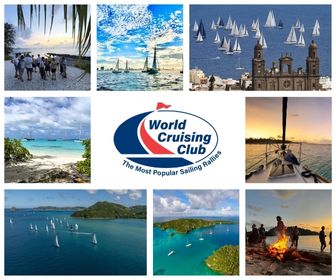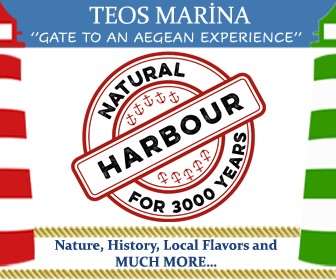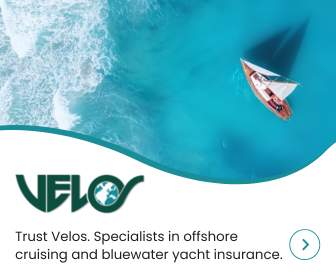Overland trucking to avoid the Red Sea
Published 13 years ago, updated 6 years ago
From Aqaba in Jordan to UAE
This route was pioneered in early 2011 by Brian and Deborah Taylor-Searle with their yacht ‘Chinook of Canada’. They recorded their experience at http://www.chinookofcanada1.blogspot.com/ as well as writing a detailed report for noonsite (see Desert Sailing).
After a number of ridiculous shipping quotes, I met with Brian and Deborah to explore the possibility of sending a larger yacht overland and subsequently used the same trucking company. I found the cost reasonable and would certainly recommend considering this option instead of shipping.
The Trucking Company
The trucking company, Nabresco www.nabresco.com are probably the largest operator in the region and certainly inspire confidence. In their office are photos of oversize loads underway – including eight 400-ton powerhouse diesel delivered from Aqaba to Mosul through the worst days of the Iraqi conflict. The project engineer for the job was Raed Naber, the young British and U.S. educated member of the owner’s family. He was a pleasure to deal with throughout and knew the route well, having shipped ‘Chinook” to the U.A.E. and also a 7-meter high tourist ‘submarine’ to Muscat in Oman in 2010.
Technical details
My yacht ‘Tramp’ is an alloy Van de Stadt Samoa 47 – 15 meters overall with a gross weight approaching 20 tons. More significantly for road transport, it has the signature Van de Stadt hard doghouse – the overall height from keel to doghouse top is 5.1 meters. To avoid numerous diversions around en route bridges at standard 5.6-meter clearance, the load was kept to 5.5 meters. The truck driver knew the required diversions but I had a few nervous moments observing his passage under bridges.
We had a choice of trailers – a purpose-built Waltron boat-hauling low flatbed or a high-bed with a central cut-out to take the keel. We took the latter choice as the supports were shorter and easier to fit. However, it did limit our options for offloading as it required a higher lift for the keel to clear the trailer – something a standard Travelift could not manage.
Loading and off-loading
The preferred northern loading port would be Latakia in Syria, but this is not available due to the current troubles so we transited Suez to load at Aqaba in Jordan. We were able to load the boat at the Royal Yacht Club of Jordan thanks to the efforts of the club manager Captain Mahmoud Abu Sheikha. He is an experienced sailor and glad to see us there amongst his fleet of motor yachts. Using the club avoided the drama of daily security passes at the main port and needing to use the port’s cranes. Aqaba is a ‘special economic zone’ which reduces complications with customs at the Jordanian end.
For offloading (or on-loading if northbound) at the southern end there are plenty of choices: Muscat or Sohar in Oman, Fujairah or Khorfakkan on the east shore of the U.A.E., or Abu Dhabi, Jebel Ali, Dubai, Al Hamriyah, or Ras al Khaimah on the Gulf coast of the U.A.E. Probably the easiest from a customs viewpoint are Jebel Ali or Al Hamriyah, both free zones. We chose Hamriyah as it is smaller and more yacht-friendly, and there is a 400-ton Travelift at Riviera Marine www.rivieraboat.com. This lift had the reach to lift the boat the required 4 meters to clear the trailer. Another 400-ton Travelift is at AM Shipyard in Abu Dhabi www.amshipyard.com [BROKEN LINK].
The Costs
Costs can be broken down thus:
- Trucking
- Customs agents – including customs & port charges
- Cranes
- Insurance & survey
My final bill was higher than the $11,000 reported by Brian and Deborah –very close to $15,000. Lifting charges were higher as I needed a crane in Aqaba instead of the RYCJ Travelift.
Customs agent charges were around $1000 for the two border crossings (Jordan-Saudi and Saudi-U.A.E.). Transit insurance is a trucking requirement and I found only a few companies willing to quote. A requirement of the insurance was an onload survey by a marine surveyor and the same again for offloading – lucrative work for the surveyors and costing more than the insurance! Surprisingly no escort vehicle was required despite the load’s 4.5-meter beam.
Border Crossing Customs Checks
It was probably a blessing that it was not possible to accompany the boat en route. The border crossing into Saudi is normally a drawn-out affair, and hiring a customs agent to clear there is mandatory. Luckily the customs inspectors didn’t want to drill holes in my keel as they did with ‘Chinook’, but they did open every compartment on board and have the sniffer dogs through. When they departed they left the main hatch open and it stayed that way – so I ended up with most of the Saudi desert on board! As well as removing alcohol and pharmaceuticals from the boat, it is essential to remove all printed matter and DVDs – otherwise, customs will go through the lot, page by page, movie by movie, even if it takes a week – and then present you with a bill.
Brian and Deborah are more qualified than I to comment on the coast-hugging route from the U.A.E./ Oman to India or vice versa. Recent reports indicate that with the increased naval presence, the pirates are staying much closer to home, but I have not yet seen that reflected in insurance rates. As an alternative to rounding the Cape of Good Hope, the overland route is feasible, moderately priced, and not too overwhelming with red tape.
Peter Forbes
SY Tramp
Related content
Related to following destinations: Abu Dhabi, Aqaba, Dubai (Port Rashid), Egypt, India, Israel, Jordan, Maldives, Muscat, Oman, Qatar, Ras al-Khaimah (Mina Saqr), Red Sea (Egypt), Saudi Arabia, Sharjah (Al Hamriyah), South Africa, Suez Canal, Thailand, Turkey, United Arab Emirates
Related to the following Cruising Resources: Cruising Information, Global Yachting Services, Red Sea, Routing, Yacht Transportation







